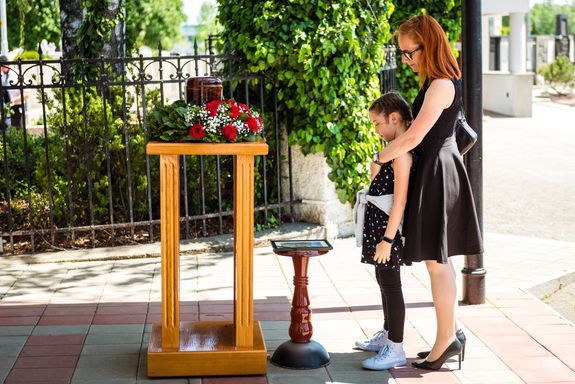What Is the Difference Between Direct Cremation and a Traditional Cremation?
Cremations are now the disposition standard for Americans, as a majority of people now consider cremation their primary option. But even among those interested in cremation, they may not know that there’s more than one way to handle the ceremony.
Specifically, there are traditional cremation services and direct cremation services. What’s the difference? That’s what we’ll address, along with why many families are considering direct cremation for their preferred cremation option.
What Does “Traditional” Mean When Referring to Traditional Cremation?
You may hear cremation services referred to as “traditional.” All this means is that there is a traditional funeral service before disposition is carried out.
If a funeral is involved, it will dictate how final arrangements are carried out. Here are a few important considerations when putting together a traditional cremation:
- The ceremony will require a funeral home – Funerals must be carried out at a funeral home. That means arrangements must be made to locate and rent out the facility for the ceremony. If the remains are to be transported from one location to another, a second funeral home may be required at both endpoints.
- Embalming and cosmetics will also be required – Embalming preserves the body so that a viewing can be included with the funeral prior to cremation. Additional cosmetic work may be required to prepare the body for a viewing.
- A rental casket will be needed for the funeral – A rental casket is required to hold the body during the funeral. This casket may or may not be cremated with the body, depending on the family’s preference. If it is not cremated with the body, the remains are instead placed in an alternative container during cremation.
- Funeral arrangements must be made quickly – Given the time-sensitive process involved, traditional funerals must be arranged and carried out quickly, typically within days of the decedent passing.
In this way, a traditional cremation is similar to a funeral and burial; only the body is cremated, and the ashes are returned to the family.
What Do Direct Cremation Services Include?
As an alternative to funeral and traditional cremation services, families may opt for a direct cremation instead. While there are more differences than similarities between the two, in the end, the family receives the cremated remains of their loved one once disposition is carried out.
Here’s what the direct cremation process looks like, from start to finish:
- The direct cremation service is dispatched to the place of death – Once the direct cremator is notified of the decedent’s passing, a recovery team is sent to the place of death to retrieve the body and return it to the morgue. This is only done after death has been confirmed by a physician.
- The remains are kept in refrigerated storage – The decedent is kept in refrigerated storage until cremation can proceed. This may take up to a week or more, but because the body is kept in refrigeration, it does not need to be embalmed.
- The direct cremation service attains approval for disposition – The direct cremator will handle the approval process for the family, which involves notifying the state prior to cremation. If needed, the service provider can also help procure and fill out any forms needed for approval.
- The body is transported to the crematory and cremated – Once approval is granted, the decedent is taken to the crematory for disposition. The family may be present during this time, but it’s not necessary. An identifying metal disc is kept with the body to ensure the right cremains are given to the family.
- The cremains are returned to the family – Following cremation, the service provider will gather the cremains and place them in a container for the family. They can then be delivered, held for pickup, or delivered to any part of the lower United States.
Three Reasons Why Families Are Choosing Direct Cremation Over Other Cremation Services
At first glance, it may seem like direct cremation is just cremation without all the frills. The process only includes the minimum needed for cremation, though additional goods and services can be added into a basic direct cremation package.
For many families, direct cremation is the right decision for their loved one. Here’s three reasons why:
- The cost of direct cremation is much lower – Compared to a traditional funeral and cremation, direct cremation services are far less expensive. A traditional cremation costs around $7,000 in Florida, for example. Direct cremation may cost less than $1,000, depending on what items or services are included, and where cremation takes place.
With its much lower cost, direct cremation relieves families of the considerable financial burden that accompanies a traditional funeral and disposition. None of us want to leave behind a burden on our loved ones, so many are choosing direct cremation to avoid it.
- Direct cremation allows families to personalize a memorial – Many Americans do not want the solemn type of traditional funeral we’ve all grown accustomed to. Instead, they want something more individual, personalized, and celebratory. It can be difficult for families to find the energy for that immediately following death.
With direct cremation, there’s no need to rush a memorial. In fact, families can wait months, or even years, before holding a proper ceremony for their loved one.
- Direct cremation is extremely easy to arrange – Because there’s no rush involved, direct cremation can be quickly arranged without additional stress. As anyone who has planned a funeral knows, there can be intense stress involved in notifying family members, contacting funeral homes and making decision after decision regarding the proper ceremony.
With direct cremation, these decisions can be given all the time they need to be made right.
Direct Cremation Is a Modern, Cost Efficient Approach to the Process
Funeral costs have been rising for years, to the point where a traditional cremation is out of reach for many families. For these families, direct cremation can be an ideal alternative. With its
budget-friendly cost structure and simplicity, more families around the U.S. are embracing the direct cremation process.


Bringing the highest quality cremation services to families in Orlando, Florida and surrounding communities in: Orange County, Osceola County, Seminole County, Marion County, Flagler County, Sumter County, and Broward County. Learn more about our service areas, click here.
Cremation Specialists of Florida
customerservice@cremationspecialists.com
1148 C East Plant St,
Winter Garden, FL, 34787
Online cremation arrangements are available 24/7
To begin the process, click here. Our online cremation service is simple to navigate, each page of the process leads you to the next, make payments online, and choose only the items that best suit your needs.
All Rights Reserved | Powered By Parting Pro | Privacy Policy



